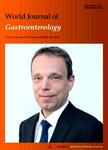Extramedullary plasmocytoma associated with a massive deposit of amyloid in the duodenum
Extramedullary plasmocytoma associated with a massive deposit of amyloid in the duodenum作者机构:Department of Pathology University Hospital of Brasília Department of Radiology University Hospital of Brasília Department of Hematology University Hospital of Brasília Department of Surgery University Hospital of Brasília
出 版 物:《World Journal of Gastroenterology》 (世界胃肠病学杂志(英文版))
年 卷 期:2009年第15卷第28期
页 面:3565-3568页
核心收录:
学科分类:1002[医学-临床医学] 100214[医学-肿瘤学] 10[医学]
主 题:Extramedullary plasmocytoma Amyloidosis Duodenum Plasma cell neoplasms Immunohistochemistry
摘 要:We report a rare case of extramedullary plasmocytoma associated with a massive deposit of amyloid in the duodenum. A 72-year-old Japanese man was admitted to our hospital presenting with a 3-mo history of epigastric pain, vomiting and weight loss. On computed tomography (CT) a wall thickening of the fourth part of the duodenum was observed. Multiple biopsies obtained from the lesion showed infiltration of plasma cells and lymphocytes, but they were not conclusive. The patient underwent resection of the lesion and, on histopathological examination, the lesion consisted of a dense and diffuse infiltrate of plasma cells and a few admixed lymphocytes with reactive follicles extending to the muscular propria. An extensive deposition of amyloid was also observed. Immunohistochemical stains revealed that a few plasmacytoid cells showed λ light chain staining, though most were κ: light chain positive. These cells also were positive for CD138 and CD56 but negative for CD20 and CD79. The findings were consistent with extramedullary plasmocytoma associated with a massive deposit of amyloid in duodenum. A subsequent workup for multiple myeloma was completely negative. The patient showed no signs of local recurrence or dissemination of the disease after 12 mo follow-up. Because of the association of plasmocytoma and amyloidosis, the patient must be followed up because of the possible systemic involvement of the neoplasm and amyloidosis in future.



